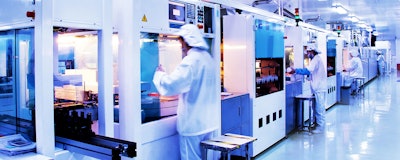
 Christina Valimaki
Christina Valimaki Computers are becoming increasingly self-aware. Technological progress based on complex algorithms, combined with greater computing and processing power, has removed several key constraints. Through machine learning and deep learning techniques, computer scientists are now able to train computers to recognize patterns when presented with new image and audio files.
Already, intelligent systems are capable of moderately accurate transcriptions from video feeds, as demonstrated by artists in Amsterdam, and we can expect the accuracy rate to continue to rise. Machine learning is still a nascent technology, but self-learning machines have huge potential to help scientists and researchers by identifying trends in the data from lab experiment instrumentation for materials innovation. This is a game-changing moment.
Experimenting in a Virtual Universe
Pursuing the most promising material or chemical innovation prospects for competitive advantage requires deep cross-disciplinary knowledge. No human could possibly have a broad and deep enough knowledge to map enough potential research paths, but the processing power of intelligent machines can. Such systems can decrease the time it takes to create a viable product by simultaneously drawing on multidisciplinary sources to run thousands of virtual experiments; the most promising of which researchers can then attempt to replicate in the real world.
Creating new materials is one of the most expensive processes manufacturers face. After identifying a specific customer need or possible megatrend, and evaluating the market to gauge profitability compared to existing products, manufacturers must analyze and recombine potentially hundreds of raw inputs to meet the desired specifications. This experimental process is time-consuming and expensive, with no guarantee of a viable product. Machine learning will accelerate this process by providing a virtual universe to analyze all hypothetical combinations — where researchers can work with imaginary chemicals in simulated projects — prior to investment in real-world experiments.
Each test increases the ability of machine learning to identify new combinations, helping manufacturers find solutions faster. Already, businesses are finding applications for this approach. Atomwise is using large scale machine learning, coupled with huge chemistry data sets, to enable the discovery of new non-toxic pesticides and safer agricultural products. The measurable impacts on the manufacturing industry include increased production rates, more efficient supply chains and reduced wastage. Researchers have also used machine learning to accelerate discovery of new materials, through iteratively designed experiments — nearly halving the time to market.
Being ‘First’ in a Competitive World
The globalization of manufacturing has resulted in a more competitive market than ever before. In order to compete, particularly with the APAC region, firms need to be able to create cheaper alternatives before anyone else. Being the first to achieve a breakthrough is the difference between success and failure — making machine learning even more critical. When combined with other innovations, such as 3D printing, the results could be significant; for example, allowing machines to autonomously test various 3D designs, achieving the optimal solution before printing.
Integrating machine learning with 3D printing could reduce costs, negate the need for assembly and improve the durability and design of the end product — which helps manufacturers be ‘first’ to market with new products. Further, if machine learning helps create a boom in 3D-printed devices, large swathes of manufacturing could be re-shored, significantly reducing the number of transportation miles expended and offering a boost to local economies.
The ‘GIGO’ Principle
None of this is to say that machine learning is a silver bullet. Even with self-educating computers, the GIGO principle — garbage in, garbage out — still applies. Without the input of accurate scientific data the results of machine learning algorithms will be at best mixed and at worst disastrous. It’s no use trying to get a computer to recognize a puppy if the data it is being fed is pictures of kittens.
Successfully using machine learning in material innovation requires clearly classified, comprehensive data from varied sources. Without this input, a machine may draw data from a single source and apply it in all calculations (‘garbage’), and fail to factor in limitations and conditions. Yet in reality, mixing two chemicals, for example, can produce radically different reactions if the ambient temperature is altered by 200 degrees — something a computer working with insufficient data won’t recognize. Further, for the scientists carrying out these experiments in the lab, it is essential the data are comprehensive and accurate, to ensure safety while pursuing innovation.
Multiple factors can affect chemical reactions, so it is crucial that machines are fed comprehensive data with context (i.e., when is information reusable? When is it not applicable?). In the same way that doctors must understand how prospective reactions between medicines could affect patients differently based on medical condition and dosage, machine learning tools need contextual data in order to evaluate the likelihood of calculations being correct. A repository of verified, cross-domain, trusted data must be the foundation of any machine learning system; so that insights are accurate, safe, based on proven data and likely to be carried out successfully in the real world.
The Rise of the Machines
Machine learning has already shown its capacity to learn and analyze, beating our best champions at complex strategy games, such as Go and Jeopardy! Coupled with other potentially revolutionary technologies — such as 3D printing and quantum computing, where the power of atoms could radically improve memory and processing capabilities — machine learning could lead to a whole new realm of manufacturing and material innovation that would be otherwise unimaginable. To usher in this machine-driven future, access to the latest advances in research, coupled with human nuance and understanding, will be critical to ensure the very best machine learning systems. Without this, we could be missing out on vital insights to revolutionize future manufacturing.
Christina Valimaki is Sr. Director of the Chemicals Industry at Elsevier R&D Solutions.























